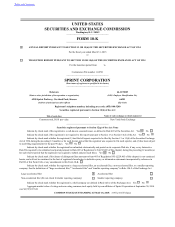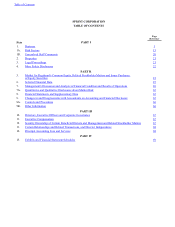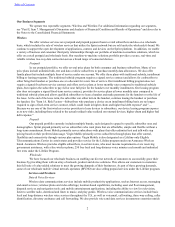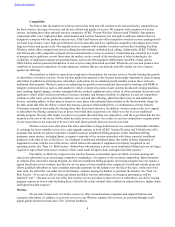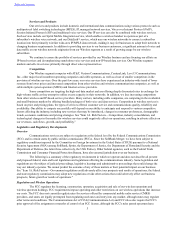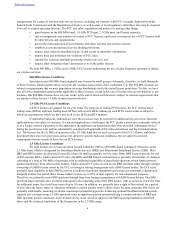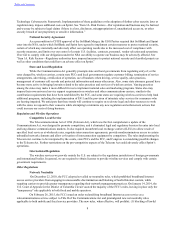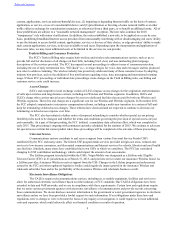Sprint - Nextel 2014 Annual Report Download - page 6
Download and view the complete annual report
Please find page 6 of the 2014 Sprint - Nextel annual report below. You can navigate through the pages in the report by either clicking on the pages listed below, or by using the keyword search tool below to find specific information within the annual report.
Table of Contents
4
Competition
We believe that the market for wireless services has been and will continue to be characterized by competition on
the basis of price, the types of services and devices offered and quality of service. We compete with a number of wireless
carriers, including three other national wireless companies: AT&T, Verizon Wireless (Verizon) and T-Mobile. Our primary
competitors offer voice, high-speed data, entertainment and location-based services and push-to-talk-type features that are
designed to compete with our products and services. AT&T and Verizon also offer competitive wireless services packaged with
local and long distance voice, high-speed Internet services and cable and have significant competitive advantages due to their
large asset bases and greater scale. Our prepaid services compete with a number of carriers and resellers including TracFone
Wireless, which offers competitively-priced calling plans that include unlimited local calling. Additionally, AT&T, T-Mobile
and Verizon also offer competitive prepaid services and wholesale services to resellers. Competition may intensify as a result
of mergers and acquisitions, as new firms enter the market, and as a result of the introduction of other technologies, the
availability of additional commercial spectrum bands, such as the 600 megahertz (MHz) band, the AWS-3 band and the
AWS-4 band, and the potential introduction of new services using unlicensed spectrum. Wholesale services and products also
contribute to increased competition. In some instances, resellers that use our network and offer similar services compete
against our offerings.
Most markets in which we operate have high rates of penetration for wireless services, thereby limiting the growth
of subscribers of wireless services. As the wireless market has matured, it has become increasingly important to retain existing
subscribers in addition to attracting new subscribers, particularly in less saturated growth markets such as those with non-
traditional data demands. Wireless carriers are addressing the growth in non-traditional data needs by working with OEMs to
integrate connected devices such as after-market in-vehicle connectivity, point-of-sale systems, kiosks and vending machines,
asset tracking, digital signage, security, smartgrid utilities, medical equipment and a variety of other consumer electronics and
appliances, which utilize wireless networks to increase consumer and business mobility. In addition, we and our competitors
continue to offer more service plans that combine voice, text and data offerings, plans that allow users to add additional
devices, including tablets, to their plans at attractive rates, plans with unlimited data included in the fixed monthly charge for
the plan, plans that offer the ability to share data among a group of related subscribers, or combinations of these features.
Consumers respond to these plans by electing those they deem most attractive. In addition, wireless carriers also try to appeal
to subscribers by offering certain devices at prices lower than their acquisition cost, which we refer to as our traditional
subsidy program. We may offer higher cost devices at greater discounts than our competitors, with the expectation that the loss
incurred on the cost of the device will be offset by future service revenue. As a result, we and our competitors recognize point-
of-sale losses that are not expected to be recovered until future periods when services are provided.
Wireless carriers now offer plans that allow subscribers to forgo traditional service contracts and handset subsidies
in exchange for lower monthly service fees, early upgrade options, or both. AT&T, Verizon Wireless and T-Mobile also offer
programs that include an option to purchase a handset using an installment billing program. Under installment billing
programs, many carriers, including Sprint, recognize a majority of the revenue associated with future expected installment
payments at the time of sale of the device. As compared to traditional subsidized plans, this results in better alignment of
equipment revenue with the cost of the device, which reduces the amount of equipment net subsidy recognized in our
operating results. See "Item 1A. Risk Factors—Subscribers who purchase a device on an installment billing basis are no longer
required to sign a fixed-term service contract, which could result in higher churn and higher bad debt expense."
Our ability to effectively compete in the wireless business is dependent upon our ability to retain existing and
attract new subscribers in an increasingly competitive marketplace. In response to the increased competition, Sprint launched
its industry-first, innovative leasing program. As with our installment billing program, our leasing program does not require a
signed fixed-term service contract, provides for service plans at lower monthly rates compared to traditional subsidy plans and
allows qualified subscribers to lease a handset and make payments for the handset over the life of the lease. At the end of the
lease term, the subscriber can either turn in the handset, continue leasing the handset or purchase the handset. See "Item 1A.
Risk Factors—If we are not able to retain and attract profitable wireless subscribers, our financial performance will be
impaired" and "—Because we are one of the first wireless service providers to lease devices to subscribers, our device leasing
program exposes us to new risks including those related to the actual residual value realized on returned devices, higher churn
and higher bad debt expense."
Wireline
We provide a broad suite of wireline services to other communications companies and targeted business and
consumer subscribers. In addition, we provide services to our Wireless segment. Our services are provided through an all-
digital global wireline network and a Tier 1 Internet backbone.

